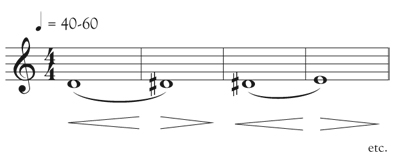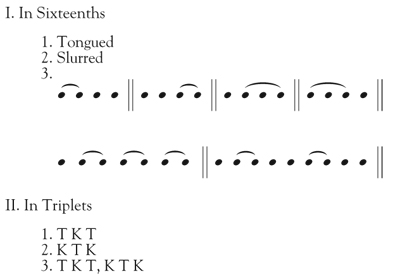Whether you are just starting on piccolo or have been playing for many years, pacing what and how you practice is an issue critical to success. I learned this the hard way many years ago when preparing for an orchestral audition. I was told at the time I was wasting my time taking this audition. While I knew it was true, I wanted the experience of going through the process. The week before the audition, I proceeded to cram and practiced about three hours a day. By the time I played the audition, my chops were totally fried. I learned a valuable lesson from this experience.
The Aperture
The piccolo aperture (opening in lips) is much smaller than it is on the flute. To achieve the best results, players should develop very fine muscle control over months of smart, thoughtful practice. At the start, it is critical to plan each practice session with breaks where the piccolo is off your face. This time could be spent on listening projects or reading about the composer, style period, or playing the piccolo in general.
Endurance levels differ for each performer. Just as an athlete needs to build up to running a marathon, it takes time to develop the ability to play a demanding concert, audition or long recording session without getting too fatigued. With practice you will learn how many weeks or months it takes to prepare well so you are neither overly tired nor underprepared for auditions or performances. Finding this balance can be tricky on piccolo.
At the Beginning
Beginning piccolo players should practice for short periods of 10-15 minutes while muscles become conditioned to the smaller embouchure. Even experienced flutists should not assume they will be able to pick up a piccolo and play for the same length of time as on flute.
After 10–15 minutes of piccolo practice, switch back to practicing on the flute. Playing with the larger flute aperture keeps the embouchure flexible and relaxed as well as providing some recovery time. Even piccolo players in good shape should not practice more than 45 minutes to an hour without taking a break.
Performance Preparation
When preparing for a recital, the goal is to be able to get through a warmup routine, several etudes, and the entire program without feeling too tired. On the day before a recital go a bit easier with a light warm-up, especially if there is a rehearsal scheduled. On the day of the recital do a light warm-up, drink plenty of fluids, and avoid foods that might cause dryness or swelling of the lips such as hot peppers, fried foods, or those with high sodium.
When preparing for a lengthy event such as a recording session that could run four to six hours long, build endurance by reading through several etudes in a row in practice sessions. If engaged to do several long sessions in a row, consider taking a day off altogether after the sessions are done if your schedule allows. Rest can be just as important as practice.
If you notice your lip start to quiver, hear unwanted buzzing in the upper register, or find that soft controlled playing is starting to suffer, this means you are tired so take a break. Do not try to push through the fatigue. Chronically fatigued muscles can result in overuse injuries.
Orchestral Demands
Playing piccolo in an orchestra offers different challenges from a recital or recording session. Orchestral composers use the piccolo as an added color to the texture. Often the piccolo is asked to enter pp after counting many measures of rests. To prepare for this type of situation, practice picking up the piccolo with no preparation and play through these entrances until they feel comfortable.
When working on long, technically difficult passages, practice them first on flute. This will save the embouchure as well as your hearing. Practicing this way will also facilitate technical execution on the piccolo. Since the keys are farther apart on the flute, learning the passage on the flute stretches the distance between the fingers. Then when playing the passage on the piccolo, the fingers are closer together, making it easier to play.
Vacation
If you have taken a vacation from playing (say a week or more) or have had a period where practice time has been limited, ease back into the practice routine rather than trying to pick up where you left off. You would not attempt a marathon after taking a month off from running.
* * *
Daily Exercises for Flexibility and Endurance
1. quarter = 40: listen for even tone and perfect intonation. Repeat on each half-step ascending chromatically.

2. The Piccolo Study Book by Patricia Morris (Novello), page 4.
3. Random attacks. Select a note randomly throughout the range and play with a perfect attack. Vary the tempo and the dynamic.
4. Half-step Hairpins. Repeat on each half-step ascending chromatically. Use sensitive fingerings if necessary. Use a tuner.

5. Exercises for the Piccolo by Jean-Louis Beaumadier (Billaudot), p. 10.
6. The Piccolo Study Book by Patricia Morris (Novello), p. 22, 23
7. Scales (Major, Minor, Modes), Arpeggios, Seventh Chords

8. Intervals (See www.flutetalkmagazine.com, Patricia George Extras)
9. Supplemental warmups: Daily Exercises for Flute, Andre Maquarre (Schirmer), Flute Workout by Robert Stallman (International) and Daily Exercises, Op. 5 by M.A. Reichert (Cundy-Bettoney)





